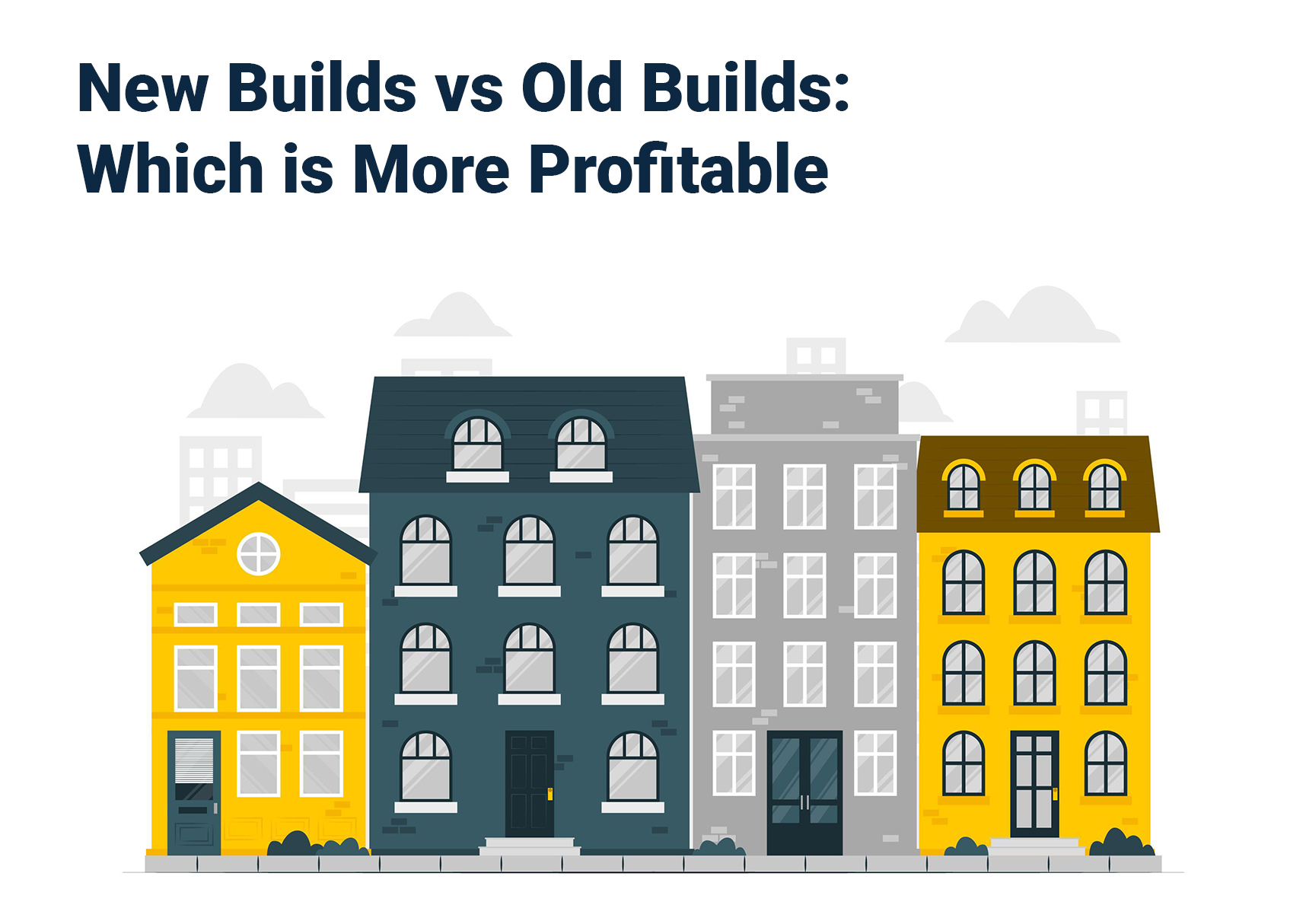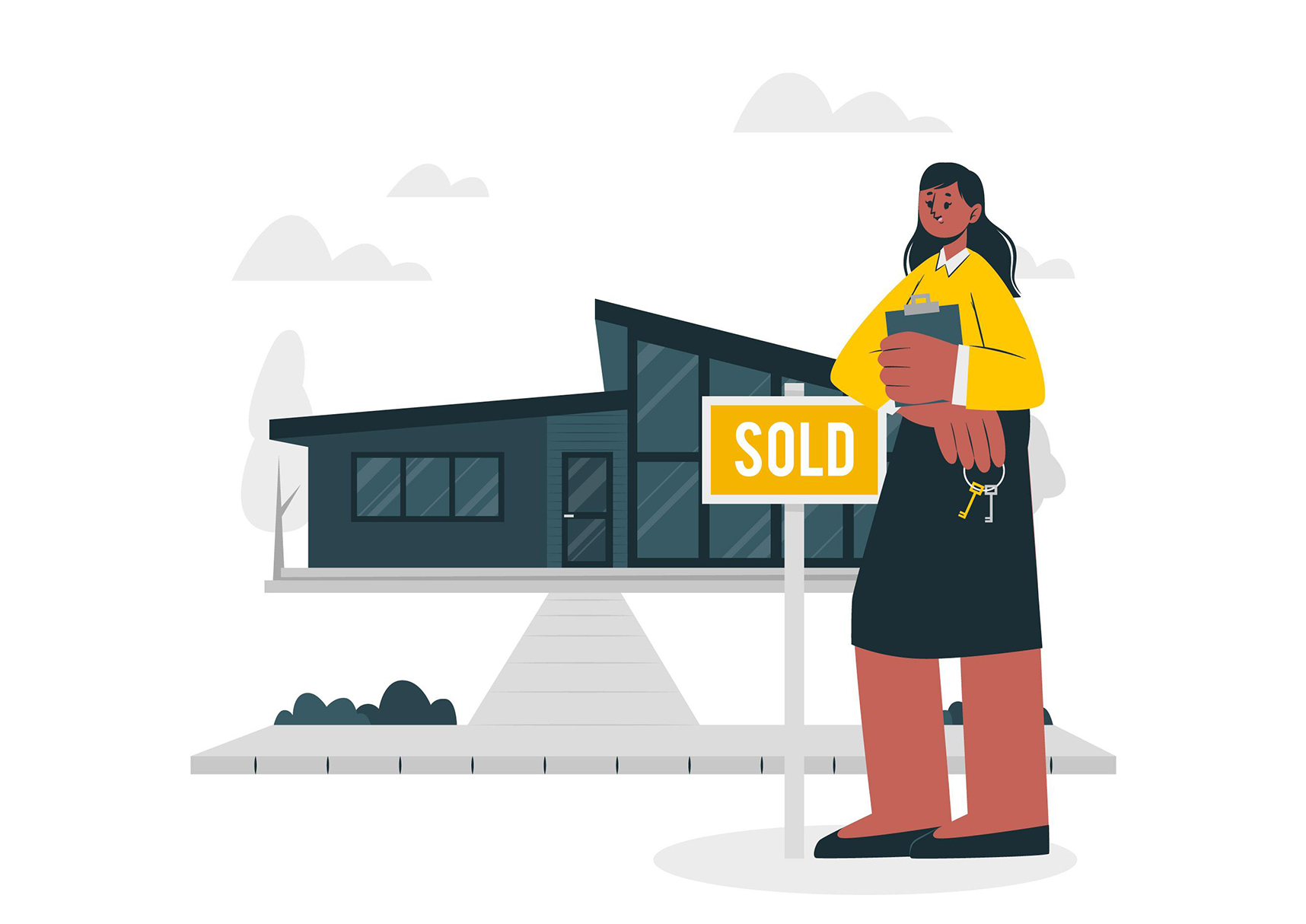New Builds vs Old Builds: Which is More Profitable

When it comes to new builds vs old builds, it’s no secret that buying a home is a huge decision. It’s important to explore all of the options. Both new build and old build properties come with pros and cons. So it’s worth taking some time to consider which is best for you.
While new build homes may come with incentives and benefits, they tend to command a higher price tag than their existing stock counterparts. And, while old builds may offer more character and more space, many will require work before they are move-in ready.
For buyers, a key question remains, which is more profitable, a new build or an old build? In this article, we take a look at the pros and cons of new builds. And how they compare to old builds to find out which is more rewarding as an investment property.
What is a New Build?
A new build is a property that has been recently constructed and never lived in. In the first half of 2022, 173,530 new homes were built in England. Which is a 5% decrease compared to the same time period in 2021.
In the same period, construction began on another 180,820 new build properties. Despite the large number of new builds arriving on the market and starting construction, it still falls short of the government’s target of building 300,000 new homes per year.
The government is attempting to increase the number of new builds in the next few years by introducing various initiatives and schemes. These include allowing developers to build higher density housing and providing grants for first-time buyers.
All of these measures will help increase the number of new builds available on the market, enabling more people to get onto the property ladder.
What is an Old Build?
An old build is classified as a property that has already had at least one existing owner. Also known as existing housing stock, these properties can be any number of years old and range from bungalows to terraced houses to detached homes.
It’s important to remember that an old build doesn’t necessarily mean a bad build. Old builds are often popular with buyers looking to renovate and make their own mark on a property. They can be found in many different locations, including rural areas, suburban neighbourhoods, and city centres. Although, they often require modernisation to bring them up to date with current building regulations.
 What are the Benefits of Buying a New Build?
What are the Benefits of Buying a New Build?
Now we understand the definition of a new build, let’s take a look at some of the benefits they offer in comparison to old build properties. Why buy new?
A home exactly how you want it
With a new build, there’s no need for work to be done before you can move in. Developers of new builds will usually give you a number of options to personalise the property how you want it done, from the kitchen to light fixtures to the layout. Many developers offer incentives like kitchen upgrades, carpets, bathroom tiling and landscaping as a bonus.
There’s no chain
Because you are buying directly from the developer, new builds are chain-free. A chain occurs when home buyers and sellers are linked together because the sale of one property requires the purchase of another.
The collapse of a property chain can make buying a house time-consuming and costly, especially if you’ve paid for an inspection or estate agent fees. With a new build, you’re buying from a business, making it less likely a sale will fall through due to a chain-related issue.
10-year warranty
All new builds come with a 10 Year NHBC warranty. This covers you if there are any problems with the build of your new home. Before completion, NHBC covers your deposit up to 10% of the property if a developer becomes insolvent. From 0-2 years, the new build developer is required to take care of any issues with the property. In years 3-10 all new builds have building warranty included.
Energy-efficient and well-designed
Modern new builds have increasingly high specifications to make them more sustainable, efficient and comfortable than before. New building regulations for 2022 are focused on energy efficiency and safety. As well as preventing energy loss and phasing out gas boilers, all new homes are required to have electric chargers installed.
Extra Perks
New builds usually come with a number of perks designed to attract buyers. These may include some or all of your stamp duty tax paid when you purchase a property. Legal fees may also be paid or home upgrades like premium carpeting, full-tiling in the bathroom, kitchen design and integrated appliances may also be thrown in.
Lower risk and easier to buy
A risk with buying an old build property is that you might be “gazumped”. This is when you have an offer accepted on the property but later down the line the seller accepts a higher offer from another party.
This can be particularly stressful when you have accrued legal fees and other costs. With a new build, because you are buying directly from a company, your purchase is lower risk and easier to buy because it’s less likely to fall through.
 What are the Advantages of Buying Old Build Properties?
What are the Advantages of Buying Old Build Properties?
While new builds come with plenty of perks, that’s not to say that old builds don’t have a number of redeeming features.
More Variety
In terms of character, old builds tend to have a greater variety of properties with different features. If aesthetics is something you value, you’re less likely to find a home that’s truly unique in character when it comes to new builds. This can also make a property more appealing to tenants or make it stand out when you come to sell.
More square footage
Old builds tend to come in more generous proportions than new builds. They offer more square footage, larger rooms and higher ceilings. With a new build, the overall space you get will be less than an older house costing the same amount.
In many new builds, gardens can be on the small size and rooms quite boxy due to smaller overall floor space. It’s easier to improve an old build by remodelling or rewiring (as long as you have the money to do so), but it’s no easy feat to make your garden or home larger if there is no free land available.
 What to Look Out for When Buying a New Build
What to Look Out for When Buying a New Build
What are some of the things a buyer of a new build needs to look out for? Which questions to ask when buying a new build? There are many perks to buying a new build but there are unique aspects to consider, which include the following:
Check the Reputation of the Developer
Even if you are sure you are buying a new build flat or house from a reputable company, it’s important to do your due diligence on who they are working with.
The last thing you want to happen is for a developer to hire an inexperienced company to do the plumbing and find out they were not up to the job. Be sure to keep an eye out for anything you feel is not quite right and be sure to mention it to the developer.
They should be able to answer any questions you have and provide evidence that the job was done correctly.
It’s also a good idea to check reviews of the developer online. See what other people have written about their experience with the developer and if there are any red flags that you need to be aware of. Do some research on the company’s background and make sure that they are legitimate.
Get Familiar with Snagging
- Snagging is a detailed check of newly built homes to flag any problems or defaults. Snags are small defects or problems that remain in the property after the completion of the building work. A snag can be something as simple as a damaged wardrobe or a part of the property that is not quite up to standard.
A snagging inspection will:
- Help to determine anything that is not entirely to the agreed standard or specification.
- Identity anything which falls below standard in terms of workmanship or quality
- Identify things in the new build which are incomplete, work that breaches safety requirements or standards that may make your property unsafe to live in.
Find out the Developer’s Plans
Be sure to check with the developers about their future plans for the area. The nice open space and woodland currently behind your property may soon become an extension of the development site. If you want to avoid living in a construction zone for 5-10 years, try to buy a property when the development is in its final phase.
Look out for Additional Costs
When buying a new build, many buyers fail to consider or budget for additional costs. These can include the landscaping of gardens, decking and fencing. Many new builds may not come with all the appliances you might think, and even items like window blinds and covers can add on thousands of pounds. These should be factored into your budget to ensure you get the best deal possible. Usually, old builds come with all these features, which could save you money.
Build Issues Won’t be Obvious
Many build issues with a home don’t start to show themselves for a few years when a building is more mature. While these costs should fall under the 10-year insurance that comes with a new build, it’s never ideal to move into a property and deal with issues down the line.
That’s why it’s important to do a thorough inspection of the property before you sign. An inspector can spot issues that may not be obvious to the untrained eye. This can help you put in a request for the builder to address any issues that might arise before you agree to purchase the property.
Consider the Neighbourhood
New build developments tend to attract first-time buyers which are young people or families with kids. It’s worth bearing in mind that these will be your neighbours for a significant amount of time.
Find out more about what to expect when buying a new build in this article.
 How Much Do New Builds go up in Value?
How Much Do New Builds go up in Value?
It’s a fact that new builds come at a price premium when compared to existing stock. Over the last 10 years, the price of new build houses has outperformed old build stock across the UK – in some areas this can be as much as 25%.
How much a new build goes up in value depends on a number of factors, in particular location and property type. New builds offer a number of advantages but there is also a risk that your property could depreciate in value once no longer considered new.
In fact, if the area is a popular spot and the demand is high, you could even see your property go up in value. Location is key when assessing how much a new build might appreciate in value. On the other hand, if there are limited amenities nearby or poor transport links, this could have a negative impact on how much your property’s value.
New builds are initially sold at a premium – as the first person to live there, you benefit from a building constructed to the latest standards, so you should pay less in upkeep and energy bills. If you plan to remain in the property for a few years, it’s unlikely you will see the effect of this initial depreciation in value.
Are New Builds Easy to Sell?
There can be a significant difference between selling a new build versus a property you’ve lived in for some time. It’s certainly possible for new builds to have a fast turn around, but a lot of data shows that buyers tend to prefer houses that weren’t built in the last 20 years (some statistics put this figure at 75%).
When considering trying to sell your new build, a number of factors make the property appealing to buyers:
- Built to Modern Standards
New builds are built with environmental protection and carbon emissions in mind. Meaning that, on the whole, they are more energy-efficient and cheaper to run.
- Modern Design
Many buyers prefer the modern design that new builds offer, making them easier to sell than properties with period pieces as they tend to better suit modern lifestyles.
 What Makes a New Build Tricky to Sell?
What Makes a New Build Tricky to Sell?
Whether or not you will lose money when selling your new build depends on a variety of factors. Generally speaking, you spend a premium to buy a new home and as soon as you buy it, it depreciates in value.
If you take a longer-term view of your investment, this initial price drop might not be a problem. However, if you are trying to sell a new build after spending only a short time in the property, you may find it challenging to get back the original paid price for a number of reasons:
Buyers prefer their own new build
Most buyers would probably prefer to purchase their own new build over one that is a year or two old and finished to someone else’s taste. If a one-year-old house is on the market for £400,000 but there are new builds on the market in the area for the same price, you may have more of a challenge selling your property.
This is because buyers are likely to want the assurance that the house and its fixtures and fittings are brand new and untouched, as well as being able to choose certain finishes to their own taste.
You probably can’t compete with developer incentives
Another challenge you may face is that developers offer incentives. Such as part exchange, to encourage buyers to purchase a brand new house. You may find yourself having to drop the price to create interest.
This is especially true if you are selling in an area where there are new developments. You may need to be creative with your marketing and look for ways to differentiate yourself from the competition.
New builds have support to buy
Buyers of new builds may qualify for the help to buy new build scheme. This would not apply to existing housing stock. Similarly, if a new build is put back on the market after a year or two, buyers – rightly or wrongly – may be suspicious that there is something not quite right with the property. This could have a negative impact on the resale value.
New Builds come with extra perks
It’s much easier for buyers to purchase a property from a company over an individual who is in a property chain which ups the risk that the purchase may fall through. Companies can also provide a more comprehensive service as they’re often backed by a team of specialists.
Also, new builds come with extra perks that you wouldn’t receive when purchasing a second-hand property. A developer is more likely to be flexible on move in days, offer perks and incentives and be more open to negotiating a deal.
How Long Will New Houses Last?
It’s not wrong to point out there is some stigma around the purchase of new builds. “Don’t buy a new build” is often a line that’s trotted out based on very little evidence. While there can be concerns over the standard of the finish, there are enough processes in place, including 10-warranty and snagging, which makes this concern mostly unfounded.
New builds don’t come with as many flaws as one might be led to believe. Stricter specification standards and more rigorous building regulations made sure of that. New builds are constantly undergoing assessments at every stage of the process. With multiple checks and tighter regulations, customers can have more confidence in what they will get from their property.
Regulations in 1992 stated that new build properties should have a 60-year lifespan. Today, the Local Government Association (LGA) has stated that a new build should last 2,000 years. Ultimately, most properties don’t need to last 2,000 years. Your biggest concern when purchasing a new build is only one thing. -Whether you can make money on it when the time comes to sell it on.
Why Are New Builds So Much More Expensive?
If you’re wondering how to buy a new house, here’s something to note. In the UK the average new build sees a price premium of 40%. In some of the areas of the UK, this figure is even higher. Some new builds in the North East can reach an average price of 65% more than the cost of the average UK home.
At the end of December 2021, the average price of a new build was £351,002. Which is £100,591 more expensive than the average price of an existing property (£250,411). A few key factors have pushed up the price of new homes to make them more expensive than existing stock:
Pandemic Challenges
The pandemic presented a number of challenges for developers. House builders faced many setbacks due to workplace restrictions. Not to mention an increase in the cost of materials and restrictions on the supply due to supply chain disruptions.
Missing New Build Targets
A skills shortage means that new builds won’t reach the government’s desired target of 300,000 new homes in 2022. Experts predict the government’s desired level of house building will be difficult to reach until 2035.
Shifts in Buyer Behaviour
The Pandemic created new trends in buyer behaviour, and the UK market received a flurry of interest. Buyer demand in the UK reached new heights. The rise in property prices to record rates soon followed due to the rapid increase in the demand for housing.
Energy Efficient
With more modern design and environmental standards, new build property prices rise at a much faster rate than existing properties. Efficiencies attract cost-conscious buyers who are seeing the cost of living rise and energy and other bills increase.
Location
Location plays a large part in the desirability of any property. New builds tend to be located in sought-after areas. Close to good transport links, good schools and within walking distance of amenities.
New Builds Make Life Easier
Everything in a house wears out sooner or later. When people move into a property that’s a pert of the existing stock, there’s usually a list of things they’d like to replace. All of which ends up costing more than they expected.
New owners may come up against unexpected surprises. Like finding out the boiler is leaking or that the windows need replacing, meaning costs can add up. New builds mean less worry about all of that for a few years. A new kitchen, bathroom, plumbing and electrics ensure nothing needs fixing when you move in except decorate.
Minimal Maintenance
New builds have to live up to regulations in terms of sound proofing, airflow and insulation, amongst other things. A brand new home’s maintenance costs should be minimal. Mainly because construction materials, systems and appliances should all be up to the latest code and meet the needs of contemporary living.
With a new build, there should be no need to worry about the roof or state of the double glazing. Also, there are no hidden costs or surprises. Newbuilds tend to make life easier for buyers and that comes at a premium.
Supply and Demand
House prices are always within the brackets of what people are willing to pay. If a new build is expensive, that’s because people are willing to pay that price for it. Primarily based on its attractiveness and elements like efficient design and a quality guarantee from the builder.
When it comes to making a decision on whether to buy a new build or purchase an old build, there are many factors to consider. New builds may offer great incentives, like support to buy. They also tend to make life easier for buyers because they are built to the latest standards. They are also less likely to require maintenance. On the other hand, new builds may present drawbacks that you won’t usually see with existing stock. This can include less space, a lack of character and a higher price tag than a similar existing property. Would you prefer to purchase an old build? Or do new builds catch your attention?
If you’re considering purchasing a new build but want to know more about what may be right for you, get in touch with our expert property team.

